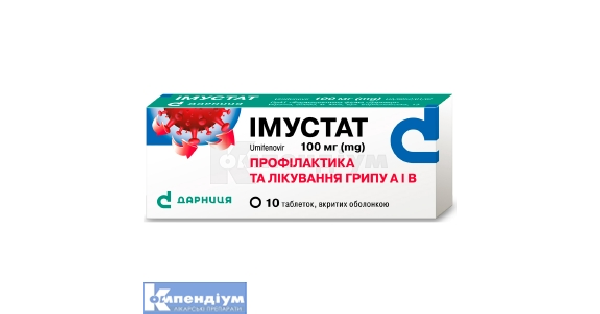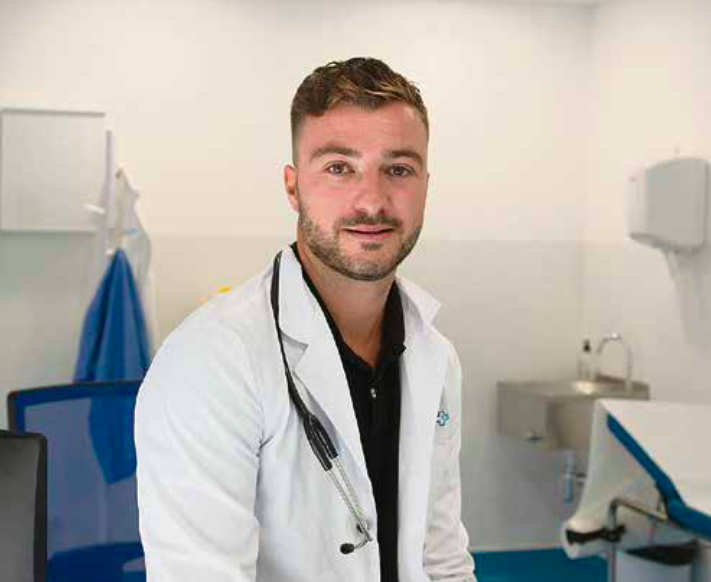

IMUSTAT

Ask a doctor about a prescription for IMUSTAT

How to use IMUSTAT
INSTRUCTIONS for medical use of the medicinal product ASTRACITRON (ASTRACITRONE)
Composition
active substances: 1 sachet contains 500 mg of paracetamol, 10 mg of phenylephrine hydrochloride, 20 mg of pheniramine maleate, 50 mg of ascorbic acid; excipients: excipients: citric acid monohydrate; glucose monohydrate; sodium citrate; colloidal anhydrous silicon dioxide; colorant "Quinoline Yellow" (E104); flavor "Lemon", or flavor "Orange", or flavor "Raspberry".
Pharmaceutical form
Powder for oral solution.
Main physical and chemical properties
Powder is white or almost white in color with a fruity smell.
Pharmacotherapeutic group
Analgesics and antipyretics. Paracetamol, combinations without psychopleptics.
ATC code N02B E51.
Pharmacological properties
Pharmacodynamics
Paracetamol has antipyretic, analgesic, and weak anti-inflammatory effects. It inhibits prostaglandin synthesis in the central nervous system (CNS) and blocks the conduction of pain impulses.
Pheniramine maleate is a histamine H1-receptor blocker, reduces vascular permeability, eliminates lacrimation, itching of the eyes and nose.
Phenylephrine hydrochloride is an alpha-adrenomimetic, has a vasoconstrictive effect, reduces swelling of the nasal mucosa and paranasal sinuses.
Ascorbic acid enhances the body's non-specific resistance.
Pharmacokinetics
Paracetamol is well absorbed, passes through the placental barrier, slightly penetrates into breast milk, is metabolized by the cytochrome P450 system, excreted by the kidneys, the half-life is 1-4 hours. The duration of action is 3-4 hours.
Pheniramine maleate is well absorbed from the gastrointestinal tract. It is metabolized in the liver by the cytochrome P450 system, the half-life is 16-18 hours, 70-83% is excreted by the kidneys.
The effect of phenylephrine hydrochloride occurs quickly and lasts for about 20 minutes. It is metabolized in the liver or gastrointestinal tract, excreted by the kidneys.
Ascorbic acid is quickly absorbed from the gastrointestinal tract, metabolized in the liver, excreted by the kidneys.
Clinical characteristics
Indications
Symptomatic treatment of acute respiratory infections and influenza:
- increased body temperature,
- headache,
- nasal congestion,
- weakness,
- pain and muscle ache.
Contraindications
Increased sensitivity to the active substances or to other components of the medicinal product; severe liver and/or kidney function disorders; congenital hyperbilirubinemia; glucose-6-phosphate dehydrogenase deficiency; phenylketonuria, alcoholism; blood diseases; leukopenia; anemia; severe forms of arrhythmia, arterial hypertension, atherosclerosis, coronary heart disease; hyperthyroidism; acute pancreatitis; prostatic hyperplasia with urinary retention; obstruction of the urethra; pyloroduodenal obstruction; bronchial asthma; closed-angle glaucoma; pheochromocytoma; thrombosis; thrombophlebitis; diabetes mellitus; epilepsy; states of increased excitability; sleep disorders, concomitant treatment with tricyclic antidepressants, beta-blockers, other sympathomimetics, appetite suppressants, and amphetamine-like psychostimulants; concomitant use with MAO inhibitors within 2 weeks after treatment.
Interaction with other medicinal products and other types of interactions
The rate of paracetamol absorption may increase when used with metoclopramide and domperidone, and decrease with cholestyramine (this effect is minor if cholestyramine is used 1 hour after paracetamol). With prolonged use of paracetamol, the anticoagulant effect of warfarin and other coumarin derivatives may be enhanced, and the risk of bleeding may increase. With episodic use of paracetamol, this effect is not pronounced. Barbiturates reduce the antipyretic effect of paracetamol. Hepatotoxic drugs increase the likelihood of paracetamol accumulation and overdose. The risk of hepatotoxicity of paracetamol increases when taking drugs that induce liver microsomal enzymes (barbiturates; anticonvulsants - phenytoin, phenobarbital, carbamazepine, and antitubercular - rifampicin, isoniazid). Paracetamol reduces the effectiveness of diuretics, may prolong the half-life of chloramphenicol; may induce metabolism of lamotrigine in the liver, thereby reducing its bioavailability and effectiveness. With regular use of paracetamol and zidovudine, neutropenia and increased risk of liver damage are possible. When taking probenecid, the dose of paracetamol should be reduced, as it affects the metabolism of paracetamol. Paracetamol may affect the results of uric acid determination by the phosphor-tungstic acid method. Hepatotoxicity of paracetamol may be increased with prolonged or excessive alcohol consumption. It is not recommended to use it concomitantly with alcohol.
The interaction of phenylephrine with MAO inhibitors causes a hypertensive effect, with tricyclic antidepressants (amitriptyline) - increases the risk of cardiovascular side effects, with digoxin and cardiac glycosides - leads to arrhythmias and myocardial infarction, with other sympathomimetics increases the risk of cardiovascular side effects and hypertension, may reduce the effectiveness of beta-blockers and other antihypertensive drugs (reserpine, methyldopa, debrisoquine, guanethidine) with increased risk of arterial hypertension and cardiovascular side effects. Concomitant use of phenylephrine with ergot alkaloids (ergotamine and methysergide) may increase the risk of ergotism.
Ascorbic acid, when taken orally, enhances iron absorption; increases the level of ethinyl estradiol, penicillins, tetracyclines; reduces the level of antipsychotic drugs, phenothiazine derivatives in the blood; reduces the effectiveness of heparin and indirect anticoagulants; increases the risk of crystalluria when treated with salicylates and the risk of glaucoma when treated with glucocorticosteroids; large doses reduce the effectiveness of tricyclic antidepressants. Ascorbic acid can be taken only 2 hours after injection of deferoxamine, as their concomitant use increases the toxicity of iron, especially in the myocardium, which can lead to cardiac decompensation. Prolonged use of large doses in treatment with disulfiram inhibits the disulfiram-alcohol reaction. Absorption of ascorbic acid is reduced when taking oral contraceptives, consuming fruit or vegetable juices, alkaline drinks.
Pheniramine enhances the anticholinergic effect of atropine, spasmolytics, tricyclic antidepressants, antiparkinsonian drugs, inhibits the action of anticoagulants. Concomitant use of pheniramine with sedatives, barbiturates, tranquilizers, anesthetics, narcotic analgesics, alcohol can significantly increase its sedative effect.
It is recommended to be cautious when using paracetamol with flucloxacillin, as concomitant use is associated with metabolic acidosis with a high anion gap, especially in patients with risk factors (see "Special warnings and precautions for use").
Special warnings and precautions for use
Do not exceed the recommended doses. If symptoms do not improve within 5 days or are accompanied by high fever, fever lasting more than 3 days, rash, or prolonged headache, consult a doctor, as these symptoms may be signs of a more serious disease.
In connection with the risk of severe liver damage in case of overdose, do not use concomitantly with other drugs for symptomatic treatment of colds and flu (vasoconstrictors and drugs containing paracetamol). Use with caution in patients with Raynaud's disease, arterial hypertension, heart disease, arrhythmias, bradycardia, thyroid disorders, liver and kidney diseases, acute hepatitis, glaucoma, chronic lung diseases, prostatic hyperplasia (as there is a risk of urinary retention), elderly patients, with increased blood coagulation, hemolytic anemia, with chronic malnutrition, dehydration, stenosing peptic ulcer. The risk of hepatotoxicity is increased in individuals with alcoholic liver damage and those who abuse alcohol.
The drug contains: phenylephrine, which can cause angina attacks; sucrose, which is contraindicated in patients with intolerance and impaired absorption of fructose, glucose-galactose, or sucrose-isomaltose. If the patient has established intolerance to some sugars, consult a doctor before taking this medicinal product, use with caution in patients with diabetes mellitus. May be harmful to teeth.
Before using the drug, consult a doctor if you have: liver or kidney disease; taking warfarin or similar anticoagulants; taking analgesics every day for mild arthritis; bronchopulmonary diseases (asthma, emphysema, chronic bronchitis).
The drug may affect the results of laboratory tests for blood glucose, uric acid, creatinine, inorganic phosphates. May be a negative test result for hidden blood in stool.
In patients with severe infections (sepsis), in which the level of glutathione is reduced, when taking paracetamol, the risk of metabolic acidosis increases, its symptoms - deep, rapid or difficult breathing, nausea, vomiting, loss of appetite, in this case, you should immediately consult a doctor.
It is not recommended to take this drug in the evening, as ascorbic acid in large doses has a mild stimulating effect. Due to the stimulating effect of ascorbic acid on the production of corticosteroid hormones, monitoring of kidney function and blood pressure is required.
Use with special caution in patients with iron metabolism disorders (hemochromatosis, thalassemia), with nephrolithiasis in history (risk of hyperoxaluria and oxalate sedimentation in the urinary tract after taking large doses of ascorbic acid).
Prolonged use of large doses of ascorbic acid can accelerate its own metabolism, after which, after discontinuation of treatment, a paradoxical hypovitaminosis is possible. It is not recommended to use concomitantly with other drugs containing vitamin C. Absorption of ascorbic acid may change with impaired intestinal motility, enteritis, or reduced gastric secretion.
It is recommended to be cautious when using paracetamol with flucloxacillin due to the increased risk of metabolic acidosis with a high anion gap, especially in patients with severe renal insufficiency, sepsis, malnutrition, and other sources of glutathione deficiency (e.g., chronic alcoholism), as well as those taking maximum daily doses of paracetamol. Close monitoring, including measurement of 5-oxoproline in urine, is recommended.
Excipients
Glucose. If the patient has established intolerance to some sugars, consult a doctor before using this medicinal product.
Colorant "Yellow Sunset FCF" (E 110). May cause allergic reactions.
Use during pregnancy or breastfeeding
The medicinal product is contraindicated during pregnancy or breastfeeding. The effect of the drug on fertility has not been specifically studied. Preclinical studies have not revealed any special effect of paracetamol on fertility when used in therapeutic doses. There have been no adequate studies on the reproductive toxicity of phenylephrine and pheniramine in animals.
Ability to affect the speed of reaction when driving vehicles or working with other mechanisms
Since the medicinal product can cause drowsiness and other side effects from the nervous system and organs of vision, it is not recommended to drive a car and work with complex mechanisms when using it.
Methods of use and doses
The medicinal product is used for adults and children over 14 years old.
The contents of the package should be dissolved in a glass of hot water (not boiling water) and drunk. The drug can be taken repeatedly every 3-4 hours, but no more than 3 packages per day.
The maximum duration of use is 5 days.
Children
The drug is contraindicated in children under 14 years old.
Overdose
Paracetamol: within the first 24 hours, pallor of the skin, nausea, vomiting, anorexia, and abdominal pain appear. When taking large doses, disorders of orientation, psychomotor excitement, dizziness, sleep disturbances, heart rhythm, pancreatitis, hepatonecrosis may be observed. The first sign of liver damage may be abdominal pain, which may not always occur within the first 12-48 hours, but may occur later, up to 4-6 days after taking the drug. Liver damage usually occurs within 72-96 hours after taking the drug. Metabolic disorders of glucose and metabolic acidosis, bleeding may occur. With prolonged use of high doses, aplastic anemia, pancytopenia, agranulocytosis, neutropenia, leukopenia, thrombocytopenia are possible.
In individual cases, acute renal failure with necrosis of the tubules is possible, which can occur even in the absence of severe liver damage, manifested by severe back pain, hematuria, proteinuria. Nephrotoxicity is possible: kidney colic, interstitial nephritis, capillary necrosis.
Administration to adults of 10 g or more of paracetamol and more than 150 mg/kg body weight in children, especially with alcohol, can lead to hepatocellular necrosis with the development of encephalopathy, bleeding, hypoglycemia, liver coma, and fatal outcome. In patients with risk factors (prolonged treatment with carbamazepine, phenobarbital, phenytoin, primidone, rifampicin, or other drugs that induce liver enzymes; alcohol abuse; glutathione cachexia (gastrointestinal disorders, cystic fibrosis, HIV infection, hunger, cachexia)), the use of 5 g or more of paracetamol can lead to liver damage.
In case of overdose, immediate medical attention is necessary. The patient should be taken to the hospital immediately, even if there are no early symptoms of overdose. Symptoms may be limited to nausea and vomiting or may not reflect the severity of the overdose or the risk of organ damage. Within the first hour after overdose, activated charcoal should be taken. The concentration of paracetamol in the blood should be measured after 4 hours or later after administration (earlier concentrations are not reliable). Treatment with N-acetylcysteine can be used within 24 hours after taking paracetamol, but the maximum effect occurs when used within the first 8 hours, after which its effectiveness decreases sharply. If necessary, intravenous administration of N-acetylcysteine should be used according to the established dosage regimen. As an alternative, in the absence of vomiting, in remote areas from the hospital, oral methionine can be used.
Phenylephrine: hyperhidrosis, psychomotor excitement or CNS depression, headache, dizziness, drowsiness, disturbances of consciousness, arrhythmias, tremors, hyperreflexia, convulsions, nausea, vomiting, irritability, restlessness, arterial hypertension; in severe cases - coma. To eliminate hypertensive effects, alpha-receptor blockers can be used intravenously; for convulsions - diazepam.
Pheniramine: atropine-like symptoms occur: mydriasis, photophobia, dryness of the skin and mucous membranes, hyperthermia, atony of the intestine. CNS depression leads to disorders of the respiratory and cardiovascular systems (bradycardia, arterial hypotension, collapse). Symptoms caused by the mutual potentiation of the parasympatholytic effect of pheniramine and the sympathomimetic effect of phenylephrine: drowsiness, which can be followed by excitement (especially in children) or CNS depression, visual disturbances, rash, persistent headache, nervousness, insomnia, hyperreflexia, irritability, circulatory disorders, bradycardia. There is no specific antidote for the treatment of overdose with antihistamine drugs. Standard first aid should be provided, including administration of activated charcoal, saline laxative, and standard measures to support the cardiovascular system. Stimulants should not be used; for the treatment of arterial hypotension, vasoconstrictor agents can be used.
Ascorbic acid: nausea, vomiting, or diarrhea (which disappear after its cancellation); bloating and abdominal pain, itching, skin rash, increased excitability. Doses over 3000 mg can cause temporary osmotic diarrhea and gastrointestinal disorders, disturbances of zinc, copper, and dystrophy of the myocardium; with prolonged use in large doses, suppression of the function of the insulin apparatus of the pancreas and glucosuria are possible. Overdose can lead to changes in renal excretion of ascorbic acid and uric acid during acetylation of urine with the formation of oxalate stones. Treatment is symptomatic: within the first 6 hours, it is necessary to rinse the stomach, and within the first 8 hours - to introduce methionine orally or cysteine or N-acetylcysteine intravenously.
Side effects
From the skin and subcutaneous tissue: rash, itching, dermatitis, urticaria, multiform exudative erythema, Stevens-Johnson syndrome, Lyell's syndrome.
From the immune system: hypersensitivity reactions, including anaphylactic shock, angioedema.
From the nervous system: headache, dizziness, tremors, anxiety, nervousness, irritability, fear, insomnia, drowsiness, confusion, hallucinations, psychomotor excitement, disorientation, depressive states, paresthesia, tinnitus, in individual cases - coma, convulsions, dyskinesia, changes in behavior.
From the respiratory system: bronchospasm in patients sensitive to acetylsalicylic acid and nonsteroidal anti-inflammatory drugs.
From the organs of vision: visual disturbances and accommodation, mydriasis, increased intraocular pressure, dryness of the eyes.
From the gastrointestinal tract: nausea, vomiting, heartburn, dryness in the mouth, discomfort and abdominal pain, constipation, diarrhea, meteorism, anorexia, aphthae, hypersalivation, hemorrhages, irritation of the mucous membranes.
From the hepatobiliary system: liver function disorders, hypertransaminasemia, usually without jaundice, hepatonecrosis (when using high doses).
From the endocrine system: hypoglycemia, up to hypoglycemic coma.
From the blood and lymphatic system: anemia, including hemolytic, sulfhemoglobinemia, and methemoglobinemia (cyanosis, dyspnea, chest pain), bruising or bleeding, thrombocytopenia, neutropenia, agranulocytosis, leukopenia, pancytopenia.
From the urinary system: nephrotoxicity, interstitial nephritis, capillary necrosis, dysuria, urinary retention, and difficulty urinating, kidney colic, kidney failure.
From the cardiovascular system: arterial hypertension, tachycardia, bradycardia, increased heart rate, arrhythmia, dyspnea, chest pain, angina attacks.
Others: general weakness, malaise.
In contrast to antihistamine drugs of the second generation, the use of pheniramine is not associated with prolongation of the QT interval and cardiac arrhythmia.
Shelf life
3 years.
Storage conditions
Store in the original packaging at a temperature not exceeding 25 °C.
Store in a place inaccessible to children.
Packaging
20 g in a sachet.
10 sachets with lemon-flavored powder in a cardboard box.
10 sachets with orange-flavored powder in a cardboard box.
10 sachets with raspberry-flavored powder in a cardboard box.
Release category
Without a prescription.
Manufacturer
LTD "ASTRAFARM", Ukraine.
Location of the manufacturer and address of the place of its activity
08132, Kyiv region, Bucha district, town of Vishneve, Kyiv street, 6.
- Country of registration
- Active substance
- Prescription requiredNo
- Manufacturer
- This information is for reference only and does not constitute medical advice. Always consult a licensed doctor before taking any medication. Oladoctor is not responsible for medical decisions based on this content.
- Alternatives to IMUSTATDosage form: capsules, capsules 100mgActive substance: umifenovirPrescription not requiredDosage form: capsules, capsules 200mgActive substance: umifenovirPrescription not requiredDosage form: tablets, 50 mgActive substance: umifenovirManufacturer: ПрАТ "Фармацевтична фірма "ДарницяPrescription not required
Alternatives to IMUSTAT in other countries
The best alternatives with the same active ingredient and therapeutic effect.
Alternative to IMUSTAT in Spain
Online doctors for IMUSTAT
Discuss dosage, side effects, interactions, contraindications, and prescription renewal for IMUSTAT – subject to medical assessment and local rules.














